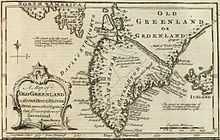Danish colonization of the Americas: Difference between revisions
Rescuing 1 sources and tagging 0 as dead. #IABot (v1.5) |
Rescuing 1 sources and tagging 0 as dead. #IABot (v1.6.1) (Balon Greyjoy) |
||
| Line 22: | Line 22: | ||
[[Arctic exploration#The North Pole|Arctic exploration]] placed claims of Danish sovereignty over the whole of Greenland in doubt: the principle of ''[[terra nullius]]'' seemed to leave huge tracts of the territory available to new entrants. Denmark responded by slowly acquiring diplomatic agreements recognizing its sovereignty from the parties involved, beginning with the treaty selling the [[Danish Virgin Islands]] to the United States in 1917.<ref name="icecave">Cavell, Janice. "[http://pubs.aina.ucalgary.ca/arctic/Arctic61-4-433.pdf Historical Evidence and the Eastern Greenland Case]". ''Arctic'', Vol. 61, No. 4 (Dec. 2008), pp. 433–441.</ref> Norway{{spaced ndash}} which had become [[Norwegian union dissolution referendum, 1905|independent of Sweden]] in 1905{{spaced ndash}} eventually protested and claimed [[Erik the Red's Land]] in eastern Greenland during 1931. The [[Permanent Court of International Justice]] ruled against Norway two years later,<ref>[http://www.icj-cij.org/pcij/serie_AB/AB_53/01_Groenland_Oriental_Arret.pdf ''Legal Status of Eastern Greenland''] {{webarchive|url=https://web.archive.org/web/20110511135249/http://www.icj-cij.org/pcij/serie_AB/AB_53/01_Groenland_Oriental_Arret.pdf |date=2011-05-11 }}, PCIJ Series A/B No. 53 (1933)</ref> albeit on questionable grounds.<ref name="icecave"/> |
[[Arctic exploration#The North Pole|Arctic exploration]] placed claims of Danish sovereignty over the whole of Greenland in doubt: the principle of ''[[terra nullius]]'' seemed to leave huge tracts of the territory available to new entrants. Denmark responded by slowly acquiring diplomatic agreements recognizing its sovereignty from the parties involved, beginning with the treaty selling the [[Danish Virgin Islands]] to the United States in 1917.<ref name="icecave">Cavell, Janice. "[http://pubs.aina.ucalgary.ca/arctic/Arctic61-4-433.pdf Historical Evidence and the Eastern Greenland Case]". ''Arctic'', Vol. 61, No. 4 (Dec. 2008), pp. 433–441.</ref> Norway{{spaced ndash}} which had become [[Norwegian union dissolution referendum, 1905|independent of Sweden]] in 1905{{spaced ndash}} eventually protested and claimed [[Erik the Red's Land]] in eastern Greenland during 1931. The [[Permanent Court of International Justice]] ruled against Norway two years later,<ref>[http://www.icj-cij.org/pcij/serie_AB/AB_53/01_Groenland_Oriental_Arret.pdf ''Legal Status of Eastern Greenland''] {{webarchive|url=https://web.archive.org/web/20110511135249/http://www.icj-cij.org/pcij/serie_AB/AB_53/01_Groenland_Oriental_Arret.pdf |date=2011-05-11 }}, PCIJ Series A/B No. 53 (1933)</ref> albeit on questionable grounds.<ref name="icecave"/> |
||
The [[Operation Weserübung|fall of Denmark]] in early 1940 increased the power and importance of the [[list of governors of Greenland|governors]] greatly, but by 1941 the island had become an American protectorate. Following the war, the former corporate policy was discontinued: the North and South Greenland colonies were united and the RGTD's monopoly officially ended.<ref>Royal Greenland. "[http://www.royalgreenland.com/en/Our-company/Our-history.aspx Our History]". Accessed 30 Apr 2012.</ref> In 1953, Greenland's colonial status was ended and it was made an integral part of the Kingdom of Denmark with representation in the [[Folketing]]. In 1979, the Folketing granted the island [[home rule#Greenland|home rule]] and, in 2009, all matters other than defense and foreign policy were transferred to the [[Parliament of Greenland|regional parliament]]. |
The [[Operation Weserübung|fall of Denmark]] in early 1940 increased the power and importance of the [[list of governors of Greenland|governors]] greatly, but by 1941 the island had become an American protectorate. Following the war, the former corporate policy was discontinued: the North and South Greenland colonies were united and the RGTD's monopoly officially ended.<ref>Royal Greenland. "[http://www.royalgreenland.com/en/Our-company/Our-history.aspx Our History] {{webarchive|url=https://web.archive.org/web/20120526113139/http://www.royalgreenland.com/en/Our-company/Our-history.aspx |date=2012-05-26 }}". Accessed 30 Apr 2012.</ref> In 1953, Greenland's colonial status was ended and it was made an integral part of the Kingdom of Denmark with representation in the [[Folketing]]. In 1979, the Folketing granted the island [[home rule#Greenland|home rule]] and, in 2009, all matters other than defense and foreign policy were transferred to the [[Parliament of Greenland|regional parliament]]. |
||
==West Indies== |
==West Indies== |
||
Revision as of 14:39, 5 December 2017
| Part of a series on |
| European colonization of the Americas |
|---|
 |
|
|

Greenland
Between the years 1605-1607, King Christian IV of Denmark commissioned three expeditions to Greenland. These expeditions were conducted in order to locate the lost Norse Eastern Settlement as well as to reassert Danish sovereignty over Greenland. The expeditions were largely unsuccessful, partly due to its leaders lacking experience with the arctic ice and difficult weather conditions. Additionally later expeditions were searching on the east coast of Greenland, which was almost inaccessible at the time due to southward-drifting ice. [4] In the 1660s, a polar bear was added to the royal coat of arms. Around this same time Dano-Norwegian ships, joined by ships from various other European countries, began journeying to Greenland to hunt bowhead whales, though no formal recolonization was attempted.

In 1721, the Norwegian
Three
Danish intervention on
The
West Indies
Explorers (mainly Norwegians), scientists, merchants (mainly Danish) and settlers from
Denmark started colonies on
In 1868, the islanders voted to sell the colony to the United States but their offer was rebuffed. In 1902, Denmark rejected an American purchase offer. In 1917, the United States purchased the islands, which had been in economic decline since the abolition of slavery.
See also
- History of Denmark
- History of Greenland
- Virgin Islands National Park
- Christiansted National Historic Site
- Danish India (Tranquebar)
References
- ^ The Fate of Greenland's Vikings, by Dale Mackenzie Brown, Archaeological Institute of America, February 28, 2000
- ^ a b c d e Marquardt, Ole. "Change and Continuity in Denmark's Greenland Policy" in The Oldenburg Monarchy: An Underestimated Empire?. Verlag Ludwig (Kiel), 2006.
- ISBN 0-7368-0939-2.
- ^ Gosch, C.C.A. Danish Arctic Expeditions, 1605 to 1620. Book I.—The Danish Expeditions to Greenland in 1605, 1606, and 1607; to which is added Captain James Hall's Voyage to Greenland in 1612 London: Hakluyt Society. 1897
- ^ Cranz, David & al. The History of Greenland: including an account of the mission carried on by the United Brethren in that country. Longman, 1820.
- ^ a b Cavell, Janice. "Historical Evidence and the Eastern Greenland Case". Arctic, Vol. 61, No. 4 (Dec. 2008), pp. 433–441.
- ^ Legal Status of Eastern Greenland Archived 2011-05-11 at the Wayback Machine, PCIJ Series A/B No. 53 (1933)
- ^ Royal Greenland. "Our History Archived 2012-05-26 at the Wayback Machine". Accessed 30 Apr 2012.
